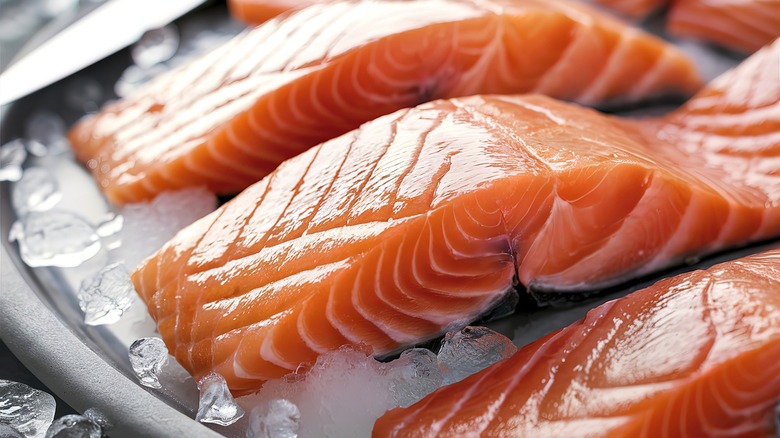Use Salt Water The Next Time You Thaw Fish – Here's Why
Thawing fish is a battleground for some as some astute consumers will notice a change in taste and texture compared to fresh fish — which is one reason why you should think twice before defrosting food in the microwave. While this hardly hampers the overall quality of the meal you make, there are still helpful ways to mitigate these changes. Food Republic spoke to Chen Ling, owner and head chef of Shōta in New York, for the best fish thawing hack — salt water.
Ling stated that "using salt water to thaw frozen fish is quick and keeps the texture and flavor better" — which helps in two main ways. As many at-home chefs will know, the flesh of thawed fish can feel mushier and slightly degraded, and the taste can seem duller than its fresh counterpart. The reason for this is that as the ice inside the fish returns to its liquid state, it seeps into the surrounding tissue, softening it. This moisture also waters down the natural flavor of the fish. This is where salt water steps in.
Even with the surprising variety of salts available, across the board, one of its primary functions in cooking is to help absorb excess moisture. When defrosting fish, the water will bring down the temperature of the fish, doing the thawing part, and the salt will help prevent the fish from becoming waterlogged and mushy. It has the added bonus of brining the fish, which the flesh helps to retain its flavor and even enhances it. This method is perfect if you need to defrost your fish quickly as it does the job without compromising on the quality. After all, water conducts heat much better than air does, so it'll be faster than fridge-thawing.
Why the water should be cold and how to season your fish
Remove your fish from its packaging and place it in a container prepared with salt water. It's true that the warmer the water, the quicker your fish will defrost, but this is not generally considered safe, according to the USDA. Bacteria have the best chance of growth between temperatures of 40 and 140 degrees Fahrenheit, and this can occur even if the center of the fish is not yet fully thawed.
If that's not enough reason to use cold water, it's not even productive to use warm salt water; the fish will thaw too fast for the salt to adequately draw out the excess moisture, thus omitting the whole point of the salt. Cool salt water should have your fish defrosted in under 30 minutes at a safe rate, and it will be ready from there to cook.
One final tip is to keep in mind that this method results in saltier fish, so when you season it before cooking, you may want to limit or omit extra salt so as not to throw off the taste too much. When in doubt, a simple ranch packet over a salmon filet can become the perfect, flavorful meal in no time.


